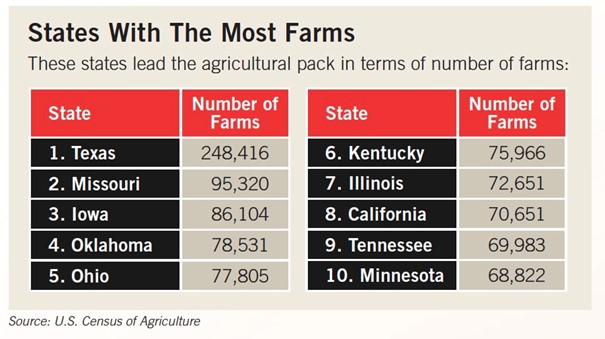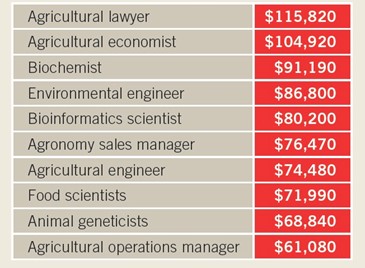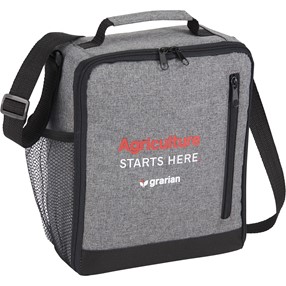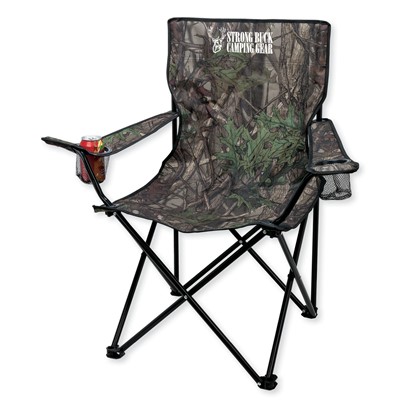Market To Market: Growing Season

You might not think much about how your food ends up on your plate, but it likely involved a long-distance journey through the food supply chain. Getting food from the farm to the fork involves many aspects of the agriculture market, which includes not just farms but also dairies, hatcheries, ranches and other enterprises involved in growing crops and raising fish and livestock. This vast field encompasses the entire food system, from the growing and raising to the producing and distributing.
In 2019, agriculture, food and related industries contributed more than $1.1 trillion to the U.S. GDP, according to the USDA Economic Research Service. By 2050, the Food and Agriculture Organization of the United Nations estimates that food production will need to increase 70 percent to accommodate the planet’s projected 9.6 billion inhabitants.
The United States, which is home to more than two million farms on more than 920 million acres, has plenty of agriculture land to rise to the challenge. According to Bloomberg, the nation’s cropland, when gathered together, would take up more than one-fifth of the 48 contiguous United States.
When it comes to tending and harvesting this farmland, the United States has an abundance of laborers. The country’s food and agriculture sector supports more than 23 million jobs, which equals nearly 15 percent of employment, according to Feeding the Economy.
Some of the country’s biggest produce crops include vegetables (U.S. farmers planted nearly 92 million acres of corn in 2019) and fruit of all kinds. However, consumers are hungry for nearly any farm-fresh, local fare. According to Forager, 96 percent of consumers say local food is the healthiest and freshest food available, and 85 percent would switch to a different grocer if that grocer carried more local food.
Amid the pandemic, consumers have clamored for healthy foods that can boost their immune systems. The Produce Marketing Association reports a surge in sales of fresh and frozen produce beginning in March 2020, with year-over-year demand for produce up double digits.
To help get consumers what they want and need during the pandemic, some farmers have shifted to selling directly to customers. Through models such as community-supported agriculture: farmers ship or deliver produce straight from the farm directly to customers, eliminating the grocery store altogether.
However farmers sell their fare, they can use promotional products to reinforce the benefits of fresh produce and keep their name top of mind with retail grocers, farmers’ market managers and consumers. Promotional products can also help brands that market to farmers, such as fertilizer companies or farm equipment manufacturers, stay visible.
In 2019, distributor sales of promotional products involving the agriculture industry topped $484 million, according to PPAI Research. Read on to learn more about cultivating business in this thriving market.
–––––––––––––––––––––––––––––––––––––––––––––––––––––––––––

Each season brings new challenges for farmers. In 2017 and 2018, floods from multiple hurricanes wiped out entire crops. In 2019, farms grappled with historically poor planting conditions. And in 2020, the pandemic brought a whole new set of trials.
With supply chains disrupted as schools, restaurants, cruise ships and other vital customers cancelled orders, many farms were forced to dump milk and dispose of fresh produce that could not be stored. The Produce Marketing Association estimates that at least $5 billion of fresh fruits and vegetables were wasted during the first few months of 2020 alone. Dairy Farmers of America estimates that farmers dumped as many as 3.7 million gallons of milk each day during the pandemic.
While farmers were forced to discard staggering amounts of produce and milk, food banks felt a crush of families to feed. According to Feeding America, more than 80 percent of food banks served more people in 2020 than they did the previous year. Some food banks reported a 200-percent increase in visitors compared to the same time period in 2019. With more people than ever visiting food banks, Feeding America estimates that one in six Americans could face hunger.
To help connect farms to food banks, numerous grassroots and regional programs have cropped up around the country, including The Farmlink Project and Mainers Feeding Mainers. Promotional products distributors can work with farms, food banks and communities on promotional campaigns to help get food where it’s needed most.

Source: U.S. Census of Agriculture
––––––––––––––––––––––––––––––––––––––––––––––––––––––––––
![]() •
•
• The number of U.S. farms peaked in 1935 at 6.8 million farms
• In 2019, the U.S. was home to 2.02 million farms, down from 2.20 million in 2007
• In the early 1970s, the average farm size was 440 acres
• In 2019, the average farm size increased slightly to 444 acres
Source: USDA Economic Research Service
–––––––––––––––––––––––––––––––––––––––––––––––––––––––––––
![]()
• About 11 percent of U.S. farmers are serving or have served in the military
• Women comprise 36 percent of all U.S. farm operators
• 56 percent of all farms have at least one female decision-maker
• The number of farm operators of Spanish, Hispanic or Latino origin is higher than ever at more than 112,400
• The number of Black farm operators has increased to over 45,400
• One in four farmers are beginners in the business with less than 10 years’ experience
Source: Farm Bureau
–––––––––––––––––––––––––––––––––––––––––––––––––––––––––––
![]()
Unlike a farm, where farmers grow crops and raise livestock for dairy products, a ranch uses the land to raise livestock, including cattle, sheep, goats and pigs. These are reportedly the seven largest in the world in terms of number of acres.
Tswalu Kalahari
South Africa
Land size: 200,000 acres
Waggoner Ranch
Texas
Land size: 520,527 acres
Vermejo Park Ranch
Colorado and New Mexico
Land size: 590,823 acres
King Ranch
South Texas
Land size: 825,000 acres
Anna Creek Station
Australia
Land size: 2 million acres
Alexandria Station
Australia
Land size: 4 million acres
Mudanjiang City Dairy Farm
Heilongjiang, China
Land size: 22.5 million acres
Source: GrizzlyRose.com
–––––––––––––––––––––––––––––––––––––––––––––––––––––––––––
![]()
Top 10 Produce Crops In The United States
- Corn
- Cotton
- Fruit
- Tree nuts
- Rice
- Soybean and oil crops
- Sugar and sweeteners
- Vegetables
- Pulses (beans, peas, legumes and peanuts)
- Wheat
Source: USDA Economic Research Service
–––––––––––––––––––––––––––––––––––––––––––––––––––––––––––
![]()
Every year, the average American eats about 2,000 pounds of food. Here’s how that breaks down:

Source: Visual Economics
–––––––––––––––––––––––––––––––––––––––––––––––––––––––––––
![]()
The agriculture field isn’t just ripe with farmers and ranchers—millions of people work in an agriculture-related field, such as food science or agricultural engineering. According to CareerAddict, about one in 12 American jobs exists in a field related to agriculture. See below for some of the field’s high-growth jobs, including their average annual salary.

–––––––––––––––––––––––––––––––––––––––––––––––––––––––––––
![]() •
•
• In 2019, the U.S. was home to 8,140 farmers’ markets
• Most markets operate June through September
• 21 percent of markets operate all year
• Fruits and vegetables comprise the most common food category at farmers’ markets, with 99.6 percent of markets selling produce
Sources: National Agricultural Statistics Service, Agricultural Statistics Board, USDA
–––––––––––––––––––––––––––––––––––––––––––––––––––––––––––
![]()
In 2019, food accounted for 13 percent of American households’ total expenditures, ranking third behind housing (32.8 percent) and transportation (17.1 percent).
Source: USDA Economic Research Service
–––––––––––––––––––––––––––––––––––––––––––––––––––––––––––
![]()
In 2019, most shoppers (81 percent) never shopped for groceries online, according to Gallup. Then, online shopping accounted for about three percent of all grocery sales, or about $1.2 billion, according to Brick Meets Click/Mercatus. In June 2020, online grocery sales had already hit $7.2 billion.
–––––––––––––––––––––––––––––––––––––––––––––––––––––––––––
![]()
Many travelers are opting to experience daily life on the farm over relaxing at a five-star hotel. According to Future Market Insights, agritourism—which involves touring agricultural areas to view farms and often participate in farming activities—is on the rise. The market is projected to grow 11 percent between 2019 and 2029, reaching $622 billion over the next eight years.
–––––––––––––––––––––––––––––––––––––––––––––––––––––––––––
![]()
According to the Census of Agriculture, the agriculture industry needs young workers. The age of the average farmer is 59.4, with only nine percent of all U.S. farmers age 35 or younger. Younger generations do not often pursue farming for a variety of reasons, including heavy physical demand, unequal work-life balance and a steep upfront investment in machinery. Promotional products distributors can work with farmers and ranchers to address these concerns and educate prospective workers about agricultural careers.
–––––––––––––––––––––––––––––––––––––––––––––––––––––––––––

With promotional products, organizations such as the National 4-H Council and the American Farm Bureau Federation (AFBF) can help spark an interest in agriculture with young people. 4-H serves every county and parish in the U.S. and collaborates with independent programs to empower more than one million youth in 50 countries. AFBF is the nation’s largest grassroots organization of farm and ranch families. The group serves people in all 50 states and Puerto Rico.
–––––––––––––––––––––––––––––––––––––––––––––––––––––––––––
![]()
Through campaigns and programs that educate, modernize and create awareness, promotional products distributors can help farmers address these top-seven issues:
- Cope with climate change, soil erosion and biodiversity loss
- Satisfy consumers’ changing tastes and expectations
- Meet rising demand for more food of higher quality
- Invest in farm productivity
- Adopt and learn new technologies
- Stay resilient against global economic factors
- Inspire young people to stay in rural areas and become future farmers
Source: Sygenta Global
–––––––––––––––––––––––––––––––––––––––––––––––––––––––––––

Farmers have it made in the shade with the Offroad Trucker Cap, which features a low profile and an adjustable snap-back closure. Choose from multiple colors to fit a farm’s branding, including camouflage and patriotic styles.

J. America / PPAI 351699, S1 / www.jamericablanks.com
–––––––––––––––––––––––––––––––––––––––––––––––––––––––––––
When shoppers are browsing farmers’ markets, the Coin Case and ID Holder Wallet keeps bills and change handy. This full-grain leather wallet is available in a range of colors and includes a zippered pocket and key ring.

Crown/IMAGEN Brands / PPAI 113430, S10 / www.crownprod.com
–––––––––––––––––––––––––––––––––––––––––––––––––––––––––––
Every farmer needs a tough, durable pair of gloves, and the Insulated Cowhide Gloves fit the bill. These gloves feature an insulated foam lining, a split-cowhide palm and a rubberized safety cuff. An elastic closure ensures a snug fit.

Starline USA, Inc. / PPAI 112719, S10 / www.starline.com
–––––––––––––––––––––––––––––––––––––––––––––––––––––––––––
The Merchant & Craft Grayley Six-Can Lunch Cooler makes a useful gift for workers at farms and ranches. Features include an interior ID label, a main compartment lined with PEVA, and a front zippered pocket for storing essentials such as utensils or hand sanitizer.

Leed’s / PPAI 112361, S13 / www.leedsworld.com
–––––––––––––––––––––––––––––––––––––––––––––––––––––––––––
After a day of toiling in the sun, farmers can relax in the Coronado Camo Folding Chair. Equipped with arm rests, two mesh cup holders and a drawstring carrying case, this chair makes a functional and comfortable gift.

Logomark, Inc. / PPAI 110898, S12 / www.logomark.com
–––––––––––––––––––––––––––––––––––––––––––––––––––––––––––
With 56 pages, the Full-Color Field Journal gives farmers plenty of space to take notes and track progress on their crops. The journal features rounded corners, lined pages and a glossy, full-color cover.

Drum-Line / PPAI 102565, S6 / www.drum-line.com
–––––––––––––––––––––––––––––––––––––––––––––––––––––––––––
Audrey Sellers is a Dallas-Fort Worth based writer and former associate editor of PPB.

